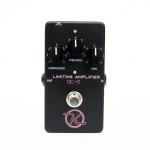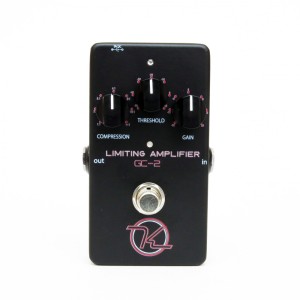Among musicians, Robert Keeley has become a virtual household name in quality  compression for well over a decade. With humble beginnings building early units based on the famed grey Ross compressor from out of his home, to now having sold over 40,000 compressors and growing his business with a complete lineup of original designs, Robert Keeley and the team at Keeley Electronics have achieved great success since the early days.
compression for well over a decade. With humble beginnings building early units based on the famed grey Ross compressor from out of his home, to now having sold over 40,000 compressors and growing his business with a complete lineup of original designs, Robert Keeley and the team at Keeley Electronics have achieved great success since the early days.
The latest designs in the company’s compression family are original and based on new circuits that Robert and his engineering team spent years perfecting. Today we’ll look review the more compact model, the Keeley GC-2 Limiting Amplifier.
Before we continue, I have to admit something. I’ve owned Keeley compressors in the past and while they definitely provide a quality compression effect that they are well-known for, I’ve never quite bonded with them or most any stompbox compressor as they tend to put a particular color “stamp” or other characteristics on the tone when active. When set for higher settings of compression, the Ross or MXR  Dynacomp style compressors especially can be noisy, have a pumping and somewhat overloaded compression effect, while also cutting off the high-end response. Some models tried to compensate with blend or tone controls, but to my ears, something was still lost and it seemed like a compromise in many respects.
Dynacomp style compressors especially can be noisy, have a pumping and somewhat overloaded compression effect, while also cutting off the high-end response. Some models tried to compensate with blend or tone controls, but to my ears, something was still lost and it seemed like a compromise in many respects.
All said, in many types of popular music, the old compressor designs provide a desirable and classic effect. And certainly Keeley’s original compressor design did improve on many of these shortcomings of the original Ross it was based on. The original Keeley compressors are low-noise designs using premium quality components and build techniques. They’re immensely popular and he’s shipped many of them for good reason!
However, personally I wanted a compressor that was truly transparent, one that produced the “feel” and smoothness of compression without delivering any sonic characteristics of compression being used as an effect that would color the signal path. Would the Keeley GC-2 Limiting Amplifier succeed? Let’s take a closer look.
The Keeley Electronics GC-2 Limiting Amplifier has basic controls for Compression, Threshold, and Gain as well as an indicator LED for threshold, true-bypass switching, and the Keeley patent-pending blue LED for overall effect indication. The circuit employs a THAT Corp IC which is an updated chip developed by former dbx engineers who created the legendary dbx 160A studio compressor.
The GC-2 is very easy to use and the manual provides good starting points and tips for setting it up. Keeley recommends to first set the Compression at 10 o’clock, Threshold at noon, and Gain at 2 o’clock. Depending on the output level of your instrument is where you determine the setting of the Threshold. Once the desired level is achieved, balance the output signal with the bypass signal using the Gain control.
A great compressor and limiter can be extremely useful for guitarists for a number of applications. I think sometimes people tend to think of them as useful simply for increasing sustain for leads, but in reality that’s just one basic application. Certainly a compressor can provide that effect: as the guitar’s signal goes down in volume when the note or chord begins to die, the compressor’s job is to raise the level and keep it audible, providing the feeling of increased sustain. With the GC-2, turning the Compression up and reducing the Threshold made the GC-2 do the job and do it well. Whether using a clean signal or playing with overdrive, the GC-2 made the guitar sing with sustain and did so with transparency and low noise that I’ve not experienced with other designs.
But what about smoothing out clean chords for rhythmic work? This is where many compressors can fall short and severely impact the tone with loss of crispness and high-end clarity. The idea here is to use the GC-2 as a limiter, meaning that you set the audio level where you want any of the peaks of the guitar’s signal to not exceed the point you set. The key here is to go lighter on the Compression settings to start and then experiment with the Threshold control and watch the Threshold indicator as you play. The LED stays lit green when there is no compression occurring and then turns red once the Threshold has been met and the pedal applies gain. In this application, the GC-2 performed like a true state-of-the art studio unit. While playing an aggressive chordal funk style, the GC-2 smoothed out any inconsistencies of my playing attack and made the guitar signal out of the amplifier sound smooth and clear like a pro. And when playing lightly, I could still retain dynamics. The tone, regardless of the setting as a limiter, retained all the clarity whether I used my Strat or Les paul – it just didn’t matter. This is a typical thorn with many older compressor designs as some favor single coils and overload with clipping when used with humbuckers regardless of the settings. The GC-2 had no favorites, and again handled both guitars with ease.
It’s no surprise then that my verdict on the new Keeley GC-2 is that it succeeds in its mission to provide studio-quality compression and limiting in a compact design, and in fact it did so greatly beyond my expectations. It is dead quiet, doesn’t alter the tone of the signal, and doesn’t provide any of the pumping sonic artifacts of older compressor designs. If you switch between turning the unit on or off during use at normal settings, you won’t even know it’s on by listening – it’s that transparent. But you WILL feel the difference and THAT is part of what makes the GC-2 so good.
Having played with or owned various boutique designs from (in no particular order): Analogman, Barber, BJF, Demeter, Diamond, HBE, and other Keeley models, in addition to standard compressors from Boss and MXR, my previous favorite was the venerable Maxon CP9 Pro+. No longer – The Keeley GC-2 gets the edge over the Maxon in its transparency, though the Maxon CP9 Pro+ is still an excellent and highly-recommended unit in its own right. Still, for what the Keeley GC-2 Limiting Amplifier delivers, all at a price point of $199, the GC-2 in my mind just became the top choice for pedal compression in a compact floor model. For those that may even want more flexibility of adjustability, the Keeley Compressor Pro adds even further options and is still based around the same circuit.
Congratulations are in order for the team at Keeley Electronics! They’ve made a name for themselves in the compressor market for well over the past decade, and now with the GC-2 Limiting Amplifier, along with the company’s other latest designs, look to be in a great position to serve customers well into the future.